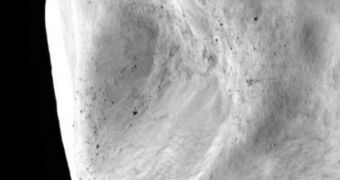According to recent observations made by a deep-space probe, it would appear that the asteroid Lutetia may be covered by a layer of dust that is up to half a mile thick.
A potential manned mission to the space rock would need to be conducted with astronauts outfitted with snowshoes, which should prevent them from getting caught in quicksand-like traps.
Investigators believe that this thick layer of sand accumulated on the space rock as a result of the fact that the asteroid has slammed into, and also been hit by, numerous other objects since it was created.
It is estimated at this point that Lutetia may have been formed from debris left behind after the birth of the Sun, and that it is therefore about 4.5 billion years old.
Models show that the dust on its surface is most likely similar in composition to the lunar rocks called regolith, samples of which have been returned to Earth by Apollo mission astronauts.
It is estimated that the debris field on Lutetia is as much as 2,000 feet (600 meters) deep at some points, and a bit shallower at others, Space reports.
Details of the recent discovery were made public in a announcement made at the American Astronomical Society's Division of Planetary Sciences meeting, which is currently being held in Pasadena, California.
The dust “must have been produced by impacts,” told colleague European Space Agency (ESA) expert Rita Schulz, who was apart of the research team.
The asteroid was analyzed from aboard the Rosetta spacecraft, which is operated by ESA. The probe did a flyby of the space rock this July, and managed to take a closer look at its surface.
The probe passed within less than 1,900 miles (3,162 kilometers) of the rock's surface, which enable its high-resolution imaging cameras to collect some outstanding images of the large asteroid.
Lutetia is indeed shaped like a potato, as predictions indicated. Its longest side spans about 130 kilometers, or 81 miles, the ESA expert added at the conference.
Another idea that the researcher presented to her colleagues was that the regolith on the Moon may have formed in the same way as the one on Lutetia.
As we already know, Earth's natural satellite has been heavily battered by asteroids and other impactors, as evidenced by the many scars it has on its surface.
Due to its intense gravitational pull, it must have attracted most of the dust that was formed following the impacts back to its surface, similarly to how Lutetia must have done as well.

 14 DAY TRIAL //
14 DAY TRIAL //